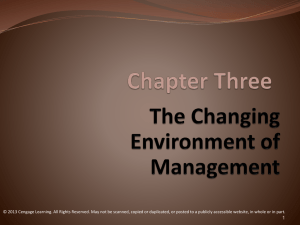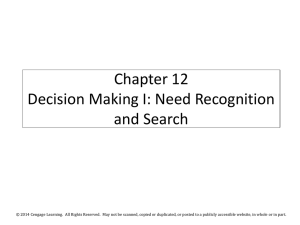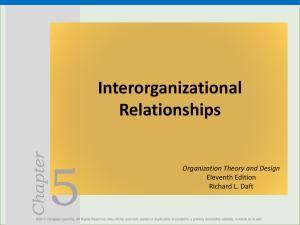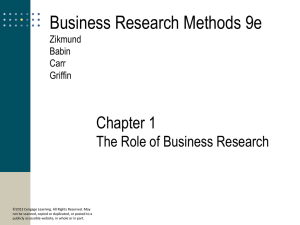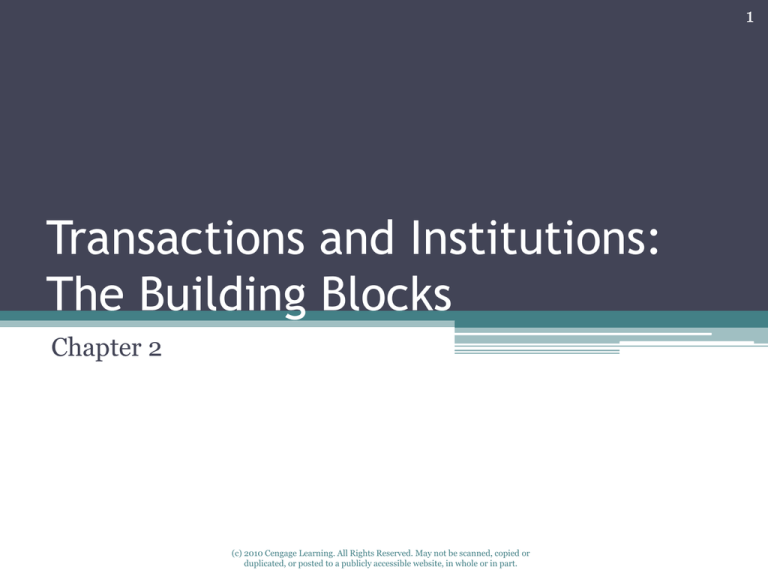
1
Transactions and Institutions:
The Building Blocks
Chapter 2
(c) 2010 Cengage Learning. All Rights Reserved. May not be scanned, copied or
duplicated, or posted to a publicly accessible website, in whole or in part.
2
(c) 2010 Cengage Learning. All Rights Reserved. May not be scanned, copied or
duplicated, or posted to a publicly accessible website, in whole or in part.
3
The Benefits of Exchange
The difference between the seller’s opportunity cost and the buyer’s
valuation is known as the economic value the transaction can create.
Here, $4 in economic value will materialize if we can reach an
agreement.
(c) 2010 Cengage Learning. All Rights Reserved. May not be scanned, copied or
duplicated, or posted to a publicly accessible website, in whole or in part.
4
What Matters and What Doesn’t
Because of the potential for a gain by both parties from a transaction,
it matters that a transaction occurs. What matters less to an economist
is the exact price at which the exchange takes place. Whatever the price,
$4 of gain is realized by the two parties. The distribution of the gain
between the parties is a normative judgment, outside the domain of an
economist to make.
(c) 2010 Cengage Learning. All Rights Reserved. May not be scanned, copied or
duplicated, or posted to a publicly accessible website, in whole or in part.
5
(c) 2010 Cengage Learning. All Rights Reserved. May not be scanned, copied or
duplicated, or posted to a publicly accessible website, in whole or in part.
6
Why Include Transactions Costs?
Suppose that arranging for the transaction involves
a transaction cost, like, the value of the time it takes to
negotiate an agreeable price. Suppose that cost is $2.
This will reduce the gains to be made from the exchange.
(c) 2010 Cengage Learning. All Rights Reserved. May not be scanned, copied or
duplicated, or posted to a publicly accessible website, in whole or in part.
7
Why Include Transactions Costs? An
Example
East of downtown Los Angeles, the suburbs of the San Gabriel Valley have become
home for upwardly mobile Hispanic and Asian families who have left the central
city. The area is also home to many recent immigrants from the Middle East, the
Near East, India, and elsewhere. For the past 20 years, Longo Toyota of El Monte
has been the country’s largest Toyota dealer. Sixty members of Longo’s 80-person
sales force are multilingual.
Longo lowers transaction costs by hiring multilingual salespeople.
(c) 2010 Cengage Learning. All Rights Reserved. May not be scanned, copied or
duplicated, or posted to a publicly accessible website, in whole or in part.
8
Making Transactions Materialize
In this transaction, if transaction costs were $5, no transaction will
occur because the transaction costs exceed the potential value of the
exchange. If transaction costs could be reduced to less than $4, the
transaction can occur.
(c) 2010 Cengage Learning. All Rights Reserved. May not be scanned, copied or
duplicated, or posted to a publicly accessible website, in whole or in part.
9
Making Transactions Materialize - Sears
Sears pioneered the mail order consumer goods
business in the late 1800’s. Sears lowered a host
of transaction costs, bringing profits to its
shareholders and lower prices to its customers.
(c) 2010 Cengage Learning. All Rights Reserved. May not be scanned, copied or
duplicated, or posted to a publicly accessible website, in whole or in part.
10
(c) 2010 Cengage Learning. All Rights Reserved. May not be scanned, copied or
duplicated, or posted to a publicly accessible website, in whole or in part.
11
Production Sets and Marginal Costs
These production sets illustrate the
number of bananas and anchovies that
can be produced using available resources.
(c) 2010 Cengage Learning. All Rights Reserved. May not be scanned, copied or
duplicated, or posted to a publicly accessible website, in whole or in part.
12
Production Sets and Marginal Costs
The marginal cost of anchovies is the number of
bananas sacrificed in order to produce
anchovies. In this example, my marginal cost
for anchovy production is ½ of a banana and
your marginal cost is 1 banana. I am the more
efficient anchovy producer.
(c) 2010 Cengage Learning. All Rights Reserved. May not be scanned, copied or
duplicated, or posted to a publicly accessible website, in whole or in part.
13
Efficiency by Command
If we start by both specializing in anchovies we can produce 9 anchovies but zero
bananas. If we are commanded to collectively produce 1 banana and as many
anchovies as possible, then you should produce the banana because we would only
sacrifice 1 anchovy. Our most efficient collective production set is given by the red
line. Combinations inside the red line are inefficient.
(c) 2010 Cengage Learning. All Rights Reserved. May not be scanned, copied or
duplicated, or posted to a publicly accessible website, in whole or in part.
14
Efficiency by Trade
I produce 2 anchovies and 2 bananas
while you produce 2 anchovies and 1
banana. Because of the difference in
marginal costs we decide that I should
give you 1.5 anchovies in exchange for
1 banana. With this trade in mind, I
produce 3.5 anchovies and 1.25 bananas
and you produce 1 anchovy and 2 bananas.
After we trade, I have 2 anchovies and 2.25
Bananas (a gain of 0.25 bananas) and you
Have 2.5 anchovies and 1 banana (a gain of
0.5 anchovies).
(c) 2010 Cengage Learning. All Rights Reserved. May not be scanned, copied or
duplicated, or posted to a publicly accessible website, in whole or in part.
15
Why the Example Matters
The moral of the story is, I give you the anchovies not
because I care about your well-being, but because I care
about mine, and you have no charitable feelings toward
me that lead you to send out the banana.
When we trade we make each other wealthier.
(c) 2010 Cengage Learning. All Rights Reserved. May not be scanned, copied or
duplicated, or posted to a publicly accessible website, in whole or in part.
16
(c) 2010 Cengage Learning. All Rights Reserved. May not be scanned, copied or
duplicated, or posted to a publicly accessible website, in whole or in part.
17
Ireland: What Happened to the
Potatoes?
In the twenty-first century, Ireland has replaced the
United States as the world’s largest exporter
of software. Land planted in potatoes fell from 1.8 million
acres in 1867 to 30,000 in 2007. Ireland now imports
most of its potatoes from the United States. As for
the United States, it is still a net exporter of
software, but imports have been rising rapidly
relative to exports. The United States never
imported many potatoes, but by 2004 it had become the
world’s largest exporter of them.
(c) 2010 Cengage Learning. All Rights Reserved. May not be scanned, copied or
duplicated, or posted to a publicly accessible website, in whole or in part.
18
Ireland: What Happened to the
Potatoes?
We can use the idea of the production set
To explain this occurrence. The
Diagram illustrates both Ireland’s and the
Unites States’ production set for
Potatoes and software. Between 1990
And 2004, the production sets shifted
And the marginal costs changed
Producing the production shifts described.
(c) 2010 Cengage Learning. All Rights Reserved. May not be scanned, copied or
duplicated, or posted to a publicly accessible website, in whole or in part.
19
What Are Resources?
Resources are whatever has value in the process
of providing goods and services that people
around the world value. Today oil is called a
resource, though it took thousands of years
before anyone discovered its uses as a fuel and a
feedstock for chemicals.
(c) 2010 Cengage Learning. All Rights Reserved. May not be scanned, copied or
duplicated, or posted to a publicly accessible website, in whole or in part.
20
(c) 2010 Cengage Learning. All Rights Reserved. May not be scanned, copied or
duplicated, or posted to a publicly accessible website, in whole or in part.
21
What Institutions Are
Economic institutions define the environment in
which we can trade. As an example, criminal law
is one of many conditions that will affect the
trades we can and cannot make.
(c) 2010 Cengage Learning. All Rights Reserved. May not be scanned, copied or
duplicated, or posted to a publicly accessible website, in whole or in part.
22
Other Examples of Institutions Contracting
I may produce a good custom-built to your
specifications that I can only sell elsewhere
at a loss if you refuse to take delivery. Our
contract (or a court) will probably require
you to pay me the difference if you refuse
the good.
(c) 2010 Cengage Learning. All Rights Reserved. May not be scanned, copied or
duplicated, or posted to a publicly accessible website, in whole or in part.
23
Other Examples of Institutions –
Market Protocols
Buyers and sellers often agree to use market protocols
to propose and make transactions. A protocol may be
imposed from above, like the U.S. government’s
systems for auctioning Treasury bills and
telecommunications frequencies, or it may have
evolved over time, like the practices automobile dealers
use to buy and sell used cars among themselves.
(c) 2010 Cengage Learning. All Rights Reserved. May not be scanned, copied or
duplicated, or posted to a publicly accessible website, in whole or in part.
24
Other Examples of Institutions Etiquette
Whether two strangers can arrange a transaction that
benefits them both can depend on whether they meet
each other’s expectations before the transaction. I
may need to credibly show that I am likely to deliver as
promised, and you must convince me that you are likely
to pay the agreed-upon amount.
(c) 2010 Cengage Learning. All Rights Reserved. May not be scanned, copied or
duplicated, or posted to a publicly accessible website, in whole or in part.
25
(c) 2010 Cengage Learning. All Rights Reserved. May not be scanned, copied or
duplicated, or posted to a publicly accessible website, in whole or in part.
26
Three Forms of Governance - Markets
A household buys vegetables and a business buys office
supplies by selecting one of the alternative sellers in a
market. We will soon define markets more precisely,
but for now think of them as facilitating the purchase
and sale of standardized goods or services, often in
repeated transactions.
(c) 2010 Cengage Learning. All Rights Reserved. May not be scanned, copied or
duplicated, or posted to a publicly accessible website, in whole or in part.
27
Three Forms of Governance Contracts
A contract is a set of promises intended to create
economic value and enforceable by a court or some
other agency, such as an arbitrator. Often a buyer and
seller can increase the economic value they create by
engaging in an unstandardized transaction.
(c) 2010 Cengage Learning. All Rights Reserved. May not be scanned, copied or
duplicated, or posted to a publicly accessible website, in whole or in part.
28
Three Forms of Governance Heirarchies
Hierarchies are command-based systems in which
prices usually play a relatively smaller role. You
cannot order a seller in a market to deliver goods
without an agreed-upon price, and unless both agree
to a change the parties to a contract can trade only at
prices specified in it. In a hierarchy, a superior can
order a subordinate to do something without
determining a price for that service.
(c) 2010 Cengage Learning. All Rights Reserved. May not be scanned, copied or
duplicated, or posted to a publicly accessible website, in whole or in part.
29
The Dimensions of Governance – Tradeoffs
Choice of governance matters for many
activities. For example, which parts of a firm’s legal
work will be performed by inhouse
lawyers and which by outside law firms? The best
choice depends on accurately assessing the costs and
benefits of the various modes of governance.
(c) 2010 Cengage Learning. All Rights Reserved. May not be scanned, copied or
duplicated, or posted to a publicly accessible website, in whole or in part.
30
The Dimensions of Governance – Mixed
Modes of Governance
A given transaction can take place under a mix of
governance modes. For instance, during a game a professional
baseball player is a subordinate who takes orders from persons
above him in a hierarchy. The team’s manager announces where he
will bat in the lineup, and if he is running the third-base coach tells
him whether to stop or try for home plate. A written contract that
runs for several years outlines the basics of the relationship between
the player and the team’s owners. At various points in his career the
player participates in a market. Teams initially compete to sign him,
and his contract will specify how soon he may become a free agent
and negotiate with any interested team.
(c) 2010 Cengage Learning. All Rights Reserved. May not be scanned, copied or
duplicated, or posted to a publicly accessible website, in whole or in part.



